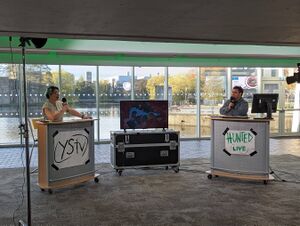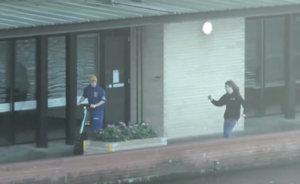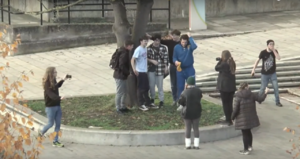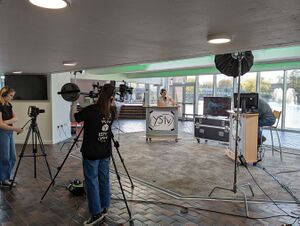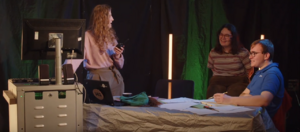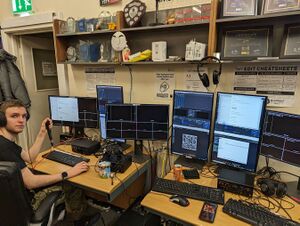YSTV Does Hunted - Live
| YSTV Does Hunted - Live | |
|---|---|
| Watch Online | |
| Genre: | Entertainment |
| Broadcast: | Saturday 3rd December 2022 |
| Executive Producer(s): | Dom Hall |
| Producer(s): | Meg Maguire, Alexianne Charlery-Warner, Sarah Maguire, Cameron Fox |
Hunted Live was the fourth installment in the YSTV Does Hunted series and the first to be restricted to the university campus. This allowed us to broadcast the entire event live.
Background
Doing a Hunted episode live had been mentioned several times, mostly as a joke, and the general consensus was that it would not really be possible. YSTV Does Hunted - Live's final form began to emerge in June 2022 after a discussion between Will Stirk and Dom Hall who thought it might actually be technically possible. The date was almost immediately set and ideas slowly progressed over the months. Proper planing started towards the end of October 2022, with a larger production and technical team brought on-board to try and make this a reality.
Pre-Prod Team
| Role | Name |
|---|---|
| Executive Producer | Dom Hall |
| Health, Safety & Welfare Lead | Rhys Milling |
| Campus Producer | Alexianne Charlery-Warner |
| Hunter HQ Producer | Meg Maguire |
| Studio Producer | Sarah Maguire |
| VT Producer | Cameron Fox |
| Director | Max Roach |
| Campus Tech Lead | Dan Wade |
| Gallery Tech Lead | Jamie Parker-East |
| Studio/HQ Tech Lead | Beth Marsch |
| Graphics Lead | Marks Polakovs |
Setup
Due to how distributed the production was across campus, there were a lot of technical challenges. The studio, which linked the different parts of the game together and kept viewers updated on what was going on, was based in Central Hall. Hunter HQ, which was where the hunters worked on tracking down contestants and interrogating them when caught, was based in the YSTV Studio. Static cameras, which acted as CCTV cameras, were placed at strategic points around campus, including on Central Hall balcony for an overview of campus. A number of roaming cameras (people's phones) went around campus with the teams to capture the action. All the static and roaming camera feeds and the outputs from the studio and HQ were sent to the gallery in the YSTV Control Room which mixed the final output.
We faced several technical challenges on the day, including difficulties getting power and internet to the static cameras resulting in the scrapping of two static locations last-minute. We had several communications issues, including our walkie-talkies not working as intended and issues with the built-in talkback feature of our remote video tool, meaning that static and roaming cameras had almost no communication with the gallery. We also had issues with the studio -> control room feed which was using SRT, this was likely because we were saturating the YSTV -> ITS network and the SRT packets were not prioritised over other traffic. This meant the video feed from the studio was very unreliable and kept dropping out, which was not ideal. This was ultimately fixed by reverting to RTMP.
Another large issue we had was lack of techies. Due to illness and no-shows, we had a lot fewer techies than planned which meant that the techies that were there were very stretched.
We were also incredibly lucky that it didn't rain on the day, otherwise we would have been completely screwed.
Remote video feeds
In order to get reasonably low-latency video feeds from static cameras and roaming camera operators who were spread out across campus, we used a remote video tool called vdo.ninja. This allowed people to send their camera feed over the internet to the gallery using just their phone and a web browser.
This tool had previously been used in productions during Covid-19, however not on the scale of this production and certainly not when we had people running around campus.
To help get the video feed from people's phones back to the gallery, people were connected to the university's eduroam WiFi network. This did mean that due to inevitable eduroam blind spots, video feeds were at time patchy or were lost altogether. However, due to large scale of the production and people moving around campus very quicky, this was unavoidable. Fortunately, vision mixers were able to cut to other video feeds or go back to the studio or Hunter HQ when this happened. We also designed the boundaries of the game to have as few eduroam blind spots as possible.
Another issue we had with vdo.ninja was communications. Whilst this tool did have an option for talkback, for reasons unknown this didn't work. This meant that roaming and static camera ops had almost no communication with the gallery; we had to resort to Facebook messenger group chats to enable at least some basic communication. This was very much not ideal.
Despite these technical issues, we were able to capture some really good content and get some really good video footage of the game. Although vdo.ninja is a free tool, it worked really well for us, especially considering how many camera feeds were going through this service.
Static CCTV Cameras
To help provide an alternate viewing angle and a more reliable feed where eduroam would have been patchy, we planned to place five cameras around campus. These would be wired to the university network, therefore allowing a more reliable feed. These static cameras were made up using 3x AC90s and 2x C100s, along with a PC at each camera to take in the video feed using a capture card. Video feeds were sent back to the gallery using vdo.ninja.
In the weeks before the production, Dan Wade spent many hours digging out old equipment and piecing together PCs and testing DeckLinks to allow us to send the camera feeds back to the gallery. Fortunately, a few weeks before the production we were donated a load of old PCs from the Computer Science department which meant that we had enough equipment to have all five static cameras.
Planned static camera locations
- 2x AC90s on Central Hall Balcony, covering Greg's Place and the area by Physics and James College
- 1x AC90 outside the old Unity Health building, covering the path towards the Quiet Place
- 1x C100 near URY/V-Bar, covering Vanbrugh Bowl
- 1x C100 covering the Quiet Place
The last two cameras had to be scrapped last-minute due to issues getting power and networking, and lack of techies to be able to figure something else out. The camera outside Unity Health almost didn't happen because we couldn't get a network connection from the Unity Health building; all network ports were dead and the wireless access point was also dead. Due to access to the old Unity Health building being awkward, we only had tested getting a wireless connection from standing outside, and assuming the network ports were working (big mistake). We had supposedly got a strong internet connection from standing outside, but on the day we found there was literally no eduroam signal available outside the building, and inside no working network ports. In hindsight, when testing, we were probably recieving an eduroam signal from elsewhere although the fact that we couldn't get a signal at all on the day suggests otherwise.
In order to solve this problem, we moved the static camera closer to the Physics building, which had working networking. We did have to wait for the Vanbrugh mobile receptionist to come open P/L/006, which is where we ran our power and ethernet from, however we were lucky that they unlocked the room for us given that we didn't have a booking. For future reference, do not rely on the Unity Health building for OBs. Also, why did we decide on using Unity Health instead of Physics in the first place? Who knows.
Because of the issues with the Unity Health static camera, we were unable to focus on the other static cameras which were ultimately scrapped. In an ideal world with more time and crew, the other CCTV cameras may have been possible. In hindsight, we should've placed the camera outside Physics in the first place, which would have saved us lots of hassle and stress. Oh well, too late now.
Studio
The studio was based in the Central Hall entrance foyer, overlooking the campus lake. The aim of the studio was to create continuity between segments, give analysis and update viewers on the game, such as the challenges the contestants had to complete.
This was a simple OB setup, with two cameras and an ATEM Mini. A Blackmagic Studio camera was used with the URSA Mini on the jib. There was also a TV on set which was used to display graphics, such as the live location of all hunters and contestants.
Due to issues with SRT, the feed being sent back to the gallery kept dropping out. This was eventually reverted to RTMP, which provided a more reliable feed.
Also, there were issues with the walkie talkies, which meant that the studio had no notice from the gallery when they were live. This caused significant frustration. We ended up resorting to phone calls to try and keep some communication, although this was still not ideal. We believe the issues with the walkie talkies were due to the distance from the gallery to central hall, the feed from the walkie talkies was unintelligible. In the future, it would probably be better to use Mumble for mid to long range comms.
Hunter HQ
The Hunter HQ was the main base for the hunters and where they schemed to track down and capture the contestants. Once captured by a hunter, the contestants were brought to Hunter HQ to be "tortured" (for legal reasons no actual torture took place) and to be interrogated.
The setup for Hunter HQ involved two Blackmagic Studio cameras, vision mixed using an ATEM Television Studio Pro 4K (which was very overkill). This feed was then sent to the primary vision mixer in the gallery.
Gallery, vision mixing and final output
All video feeds were sent to the gallery located in the YSTV Control Room. This is where they were vision mixed and sent out onto stream.
We had three assistant vision mixers to mix the following video feeds, which came from vdo.ninja:
- Roaming Camera Ops
- Team cameras
- Static CCTV cameras
After being vision mixed, these feeds were then sent to the final vision mixer, along with the feeds from the studio and Hunter HQ, which was then mixed to produce the final output on stream.
Edit0, Edit1 and Edit 3 (?) were used to vision mix by the assistant vision mixers, with the final vision mixing done on OB5.
All vision mixing was done using OBS. Remote camera feeds from vdo.ninja were added as a brower source into OBS, with the Hunter HQ and Studio feeds using SRT (later switched to RTMP due to issues with SRT).
A 15 minute delay was added to the final output on OB5, this was done to prevent any interference with the game from outside viewers.
